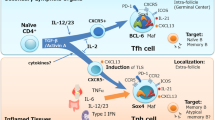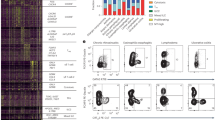Abstract
Using gene expression profiling, we show here that activation of B cells and professional antigen-presenting cells (APCs) induces the expression of common chemokines. Among these, CCL4 was the most potent chemoattractant of a CD4+CD25+ T cell population, which is a characteristic phenotype of regulatory T cells. Depletion of either regulatory T cells or CCL4 resulted in a deregulated humoral response, which culminated in the production of autoantibodies. This suggested that the recruitment of regulatory T cells to B cells and APCs by CCL4 plays a central role in the normal initiation of T cell and humoral responses, and failure to do this leads to autoimmune activation.
This is a preview of subscription content, access via your institution
Access options
Subscribe to this journal
Receive 12 print issues and online access
$209.00 per year
only $17.42 per issue
Buy this article
- Purchase on Springer Link
- Instant access to full article PDF
Prices may be subject to local taxes which are calculated during checkout






Similar content being viewed by others
References
Moser, B. & Loetscher, P. Lymphocyte traffic control by chemokines. Nature Immunol. 2, 123–128 (2001).
Luther, S. A. & Cyster, J. G. Chemokines as regulators of T cell differentiation. Nature Immunol. 2, 102–107 (2001).
Sakaguchi, S. Regulatory T cells: key controllers of immunologic self-tolerance. Cell 101, 455–458 (2000).
Shevach, E. M. Suppressor T cells: Rebirth, function and homeostasis. Curr. Biol. 10, 572–575 (2000).
Roncarolo, M. & Levings, M. K. The role of different subsets of T regulatory cells in controlling autoimmunity. Curr. Opin. Immunol. 12, 676–683 (2000).
Glynne, R. et al. How self-tolerance and the immunosuppressive drug FK506 prevent B-cell mitogenesis. Nature 403, 672–676 (2000).
Goodnow, C. C. et al. Altered immunoglobulin expression and functional silencing of self-reactive B lymphocytes in transgenic mice. Nature 334, 676–682 (1988).
Powrie, F., Carlino, J., Leach, M. W., Mauze, S. & Coffman, R. L. A critical role for transforming growth factor-β but not interleukin 4 in the suppression of T helper type 1-mediated colitis by CD45RB(low) CD4+ T cells. J. Exp. Med. 183, 2669–2674 (1996).
Takahashi, T. et al. Immunologic self-tolerance maintained by CD25+CD4+ regulatory T cells constitutively expressing cytotoxic T lymphocyte-associated antigen 4. J. Exp. Med. 192, 303–310 (2000).
Read, S., Malmstrom, V. & Powrie, F. Cytotoxic T lymphocyte-associated antigen 4 plays an essential role in the function of CD25+CD4+ regulatory cells that control intestinal inflammation. J. Exp. Med. 192, 295–302 (2000).
Thornton, A. M. & Shevach, E. M. CD4+CD25+ immunoregulatory T cells suppress polyclonal T cell activation in vitro by inhibiting interleukin 2 production. J. Exp. Med. 188, 287–296 (1998).
Itoh, M. et al. Thymus and autoimmunity: production of CD25+CD4+ naturally anergic and suppressive T cells as a key function of the thymus in maintaining immunologic self-tolerance. J. Immunol. 162, 5317–5326 (1999).
Shevach, E. M. Regulatory T cells in autoimmmunity. Annu. Rev. Immunol. 18, 423–449 (2000).
Kelsoe, G. In situ studies of the germinal center reaction. Adv. Immunol. 60, 267–288 (1995).
MacLennan, I. C. et al. The changing preference of T and B cells for partners as T-dependent antibody responses develop. Immunol. Rev. 156, 53–66 (1997).
Cyster, J. G., Hartley, S. B. & Goodnow, C. C. Competition for follicular niches excludes self-reactive cells from the recirculating B-cell repertoire. Nature 371, 389–395 (1994).
Asano, M., Toda, M., Sakaguchi, N. & Sakaguchi, S. Autoimmune disease as a consequence of developmental abnormality of a T cell subpopulation. J. Exp. Med. 184, 387–396 (1996).
Takahashi, T. et al. Immunologic self-tolerance maintained by CD25+CD4+ naturally anergic and suppressive T cells: induction of autoimmune disease by breaking their anergic/suppressive state. Int. Immunol. 10, 1969–1980 (1998).
Malanchere, E., Marcos, M. A., Nobrega, A. & Coutinho, A. Studies on the T cell dependence of natural IgM and IgG antibody repertoires in adult mice. Eur. J. Immunol. 25, 1358–1365 (1995).
Sakaguchi, S., Sakaguchi, N., Asano, M., Itoh, M. & Toda, M. Immunologic self-tolerance maintained by activated T cells expressing IL-2 receptor α-chains (CD25). Breakdown of a single mechanism of self-tolerance causes various autoimmune diseases. J. Immunol. 155, 1151–1164 (1995).
Sakaguchi, S. & Sakaguchi, N. in Autoimmunity (eds Coutinho, A. & Kazatchkine, M.) 203–227 (Wiley-Liss, New York, 1994).
Mordes J. P. et al. Transfusions enriched for W3/25+helper/inducer T lyphocytes prevent spontaneous diabetes in the BB/W rat. Diabetologica 30, 22–26 (1987).
Maloy K. J. & Powrie F. Regulatory T cells in the control of immune pathology. Nature Immunol. 2, 816–822 (2001)
Thornton, A. M. & Shevach, E. M. Suppressor effector function of CD4+CD25+ immunoregulatory T cells is antigen nonspecific. J. Immunol. 164, 183–190 (2000).
Cederbom, L., Hall, H. & Ivars, F. CD4+CD25+ regulatory T cells down–regulate co-stimulatory molecules on antigen-presenting cells. Eur. J. Immunol. 30, 1538–1543 (2000).
Willerford, D. M. et al. Interleukin-2 receptor α chain regulates the size and content of the peripheral lymphoid compartment. Immunity 3, 521–530 (1995).
Tivol, E. A. et al. Loss of CTLA-4 leads to massive lymphoproliferation and fatal multiorgan tissue destruction, revealing a critical negative regulatory role of CTLA-4. Immunity 3, 541–547 (1995).
Shull, M. M. et al. Targeted disruption of the mouse transforming growth factor-β 1 gene results in multifocal inflammatory disease. Nature 359, 693–699 (1992).
Zlotnik, A. & Yoshie, O. Chemokines: a new classification system and their role in immunity. Immunity 12, 121–127 (2000).
Seddon, B. & Mason, D. Peripheral autoantigen induces regulatory T cells that prevent autoimmunity. J. Exp. Med. 189, 877–882 (1999).
Jordan, M. S. et al. Thymic selection of CD4+CD25+ regulatory T cells induced by an agonist self-peptide. Nature Immunol. 2, 301–306 (2001).
Inaba, K. et al. Generation of large numbers of DCs from mouse bone marrow cultures supplemented with granulocyte/macrophage colony-stimulating factor. J. Exp. Med. 176, 1693–1702 (1992).
Acknowledgements
We thank D. Fearon for his support and critical reading of the manuscript; K. J. Patel, M. S. Neuberger and C. Rada for helpful discussions; T. Langford and her team for animal handling; and A. Johnson for assistance with cell sorting.
Author information
Authors and Affiliations
Corresponding author
Rights and permissions
About this article
Cite this article
Bystry, R., Aluvihare, V., Welch, K. et al. B cells and professional APCs recruit regulatory T cells via CCL4. Nat Immunol 2, 1126–1132 (2001). https://doi.org/10.1038/ni735
Received:
Accepted:
Published:
Issue Date:
DOI: https://doi.org/10.1038/ni735
This article is cited by
-
Cakes fortified with papaya seeds effectively protects against CCl4-induced immunotoxicity
Environmental Science and Pollution Research (2023)
-
The expression profiles of chemokines, innate immune and apoptotic genes in tumors caused by Rous Sarcoma Virus (RSV-A) in chickens
Genes & Immunity (2022)
-
Acute transcriptomic changes in murine RAW 264.7 cells following pseudorabies virus infection
Archives of Virology (2022)
-
Two bicistronic DNA vaccines against Vibrio anguillarum and the immune effects on flounder Paralichthys olivaceus
Journal of Oceanology and Limnology (2022)
-
Secretome of senescent hepatoma cells modulate immune cell fate by macrophage polarization and neutrophil extracellular traps formation
Medical Oncology (2022)



